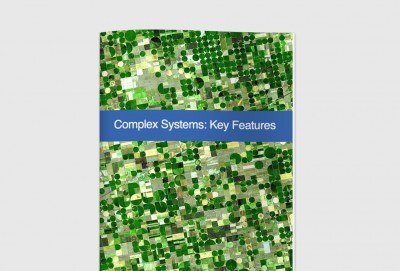“It is not only the velocity and nature of change, but also the increasing multiplicity of actors which characterizes the world of today and tomorrow… All of these accelerated trends — velocity, multiplicity, interconnectivity — are creating a completely new world in which the mastering of complexities will be the key challenge” -Prof. Klaus Schwab
The Modern Era
As the Industrial Age appears to be coming to a close we are left scrabbling for new terms to define the world we live in in the 21st century and there are no shortage of candidates from the Space Age to the Information Age to Globalization or probably the most often used term Post-Industrial society. As significant as all of these different ways of contextualizing the deep and rapid pace of change that is underway at the turn of the 21st century, they are also somewhat limiting in scope. They all capture some major trend underway but none of these are truly able to capture the breadth and depth of change, as the end of the Industrial Age means the end of the basic theory, principals and methods of the modern era (that have driven us for centuries) being called into question and faulting.
The modern scientific framework that forms/formed the backbone to our industrial civilization was born out of a revolution that had its cultural roots in the Renaissance and found its philosophical foundations in the genius of Rene Descartes, but it was really just a dream until the whole thing came together as a coherent framework with Sir Isaac Newton, this radical and bold vision of how we might see the world in terms of purely material cause and effect governed by mathematical laws of nature now had the full conceptual and technical tools needed, and for the past few centuries we have been fleshing out this framework with ever more sophistication and detail while also developing a set of industrial technologies and social institutions build upon this knowledge, giving rise to what we call the industrial age.
On a conceptual level, the 20th century was one long downhill for the dream that was born with the modern era, through the World Wars and then the rise of environmental awareness among other things, people have come to question the idea of continuous progress driven by advances in science and technology, today people are more inclined to see this vision that once inspired us as more of a nightmare as expressed in countless dystopian Hollywood films. The dream of the Renaissance artists, Descartes and Newton has been played out and it has created the world we live in, but these ideas and the ideal of continuous progress are essentially dead they can’t help us move forwards and solve the challenges we have today.
The world of the 21st century is not the world of Newton and Descartes, with the rise of information technology and globalization it is vastly more interconnected and interdependent, in a word it is complex, and it is becoming ever more apparent that the framework that drove the modern era was not designed to deal with this complexity. But to understand this lets talk a bit about what exactly complexity is.
“The global economic crisis is opening up the world as well. Our opaque institutions from the Industrial Age, everything from old models of the corporation, government, media, Wall Street, are in various stages of being stalled or frozen or in atrophy or even failing, and this is now creating a burning platform in the world”- Don Tapscott
Complexity What Is It?
What do we mean by complex? Complexity is a notoriously difficult word to define, proof of this is the long list of different interpretations for it with still no agreed upon definition. The oxford dictionary offers us this definition as; “Consisting of many different and connected parts” and they also add “A group or system of different things that are linked in a close or complicated way”. Wikipedia puts it like this; “Complexity is generally used to characterize something with many parts where those parts interact with each other in multiple ways”.
Many definitions for complexity are based on the concept of a system, with the system having many different parts that are closely interconnected and interdependent. This is part of what makes the concept of complexity so difficult to grasp and get one’s hands on as it really describes the state of things being both different(differentiated) and separate on the one hand while on the other also being interconnected and interdependent.
To understand this it helps to think about what complexity is not, it is not simple and (another seemingly trivial) observation that might help us to understand complexity is that nothing starts complex, things start simple and then develop to become complex and this is important because it means complex things always have a history and they are a product of that history. Very simple subatomic particles are known to be able to pop in and out of existence through what is called quantum fluctuation. But complex things like cats or computers do not simply pop into existence they are created through a process and they are the product of that process, as complexity theory has taught us they don’t develop through any sort of process they develop through a particular type of process called evolution.
“We live in a world characterized by evolution ”that is, by ongoing processes of development, formation, and growth in both natural and human-created systems. Biology tells us that complex,
natural systems are not created all at once but must instead evolve over
time. We are becoming increasingly aware that evolutionary processes
are ubiquitous and critical for social, educational, and technological
innovations as well”- Gerhard Fischer
The Process Of Evolution
Systems develop from simple to complex through the process of evolution that involves both differentiation and integration. Differentiation is the process of making different, the creation of diversity, all system need some degree of diversity to deal with the diversity within their environment, ecosystems need to have sufficient variety for them to be able to respond to different environmental conditions, businesses need sufficient diversity of staff for them to be able to complete all the different tasks that are required, the development of almost all type of systems involve the proliferation of sub-systems, the development of specialized components, from the growth of the human body as it starts out as a single cell to becoming a massive composite of billions of differentiated cells and organs performing specialized tasks, to the development of our universe from simple quarks to the multiplicity of complex forms of matter we see today.
But it is not just differentiation that is required for a system to stand the test of evolution and persist over time, quite the contrary too many different parts going in different directions and the organization can become chaotic and uncontrollable, things need to be able to also work together, that is coordinate and integrate their activities, the more specialized things become the more value can be gained through exchange. By coordinating their activities hunter-gather communities were able to bring down large mammoths, through the organization of millions of people we get economies that are able to create complex artifacts like airplanes and computers. Both differentiation and integration are required for a pattern of organization to persist over time but of course, the two are pulling in different directions and it is this tension between integration and differentiation that is the core of complexity and it is out of the interplay between the two that we get the process of evolution.
Following a single path way to becoming more and more integrated or more and more differentiated ultimately leads to an overly chaotic or ridged structure, as an example of this we might think about the communist economic system that strove for social and economic equality, homogeneity and integration leading to its failure to evolve in an organic fashion according to the economic interests of it members. Likewise, at the other end of the extreme the free market system that involves massive differentiation of billions of products and a socioeconomic system driven by the interests of the individual again leads to extreme inequality, divergence and social disintegration at the expense of economic interests.
Reintegration
So this is all very interesting but what does it have to do with life in the 21st century. As mentioned the modern era was born out of a radical departure from previous religious conceptions to how the world was ordered, this new vision of the world in terms of material cause and effect could be understood without reference to divine intervention, the world could now be understood by taking it apart and analyzing its parts, its designs were not written in script but could instead be decoded in the language of mathematics. Out of this basic assumption a new way of knowing was created, a new kind of science using a method of reasoning called reductionism which works by breaking things down into their constituent parts analyzing the properties of these parts and the simple linear (typically physical) interactions between them and then formalizing a description of the whole system as simply the sum of the properties of all its parts and these linear interactions. This process of reasoning is called reductionism because it reduces or breaks things down and analyses them in isolation.
Paradigms and theories are like windows onto the world they allow us to see some things but they also inhibit us from seeing others and of course, none are perfect. We create these theories and then we live inside of them, the reductionist approach has both its achievements and failures, out of it we have created a sophisticated and powerful body of knowledge that is one of humanities greatest achievements but also by breaking things down and focusing on the parts it systematically de-promotes the relations between these parts and the different levels of organization that can emerge out of them. The Newtonian paradigm, its basic set of assumptions and methods have created the industrial world we inherit from how we manage hospitals and design bridges to how we educate people and govern society the reductionist approach is an omnipresent and inherent part of the very fabric of the industrial world. The net result of this mechanistic vision to the world is what is called the Clockwork Universe, where everything starts to look like little cogs in a vast deterministic machine, it is a world of specialized components and departments that are designed to work like a predictable machine in a routine fashion. Everything that doesn’t fit into a department or component is excluded thus giving rise to its counterpart of alternativism, inherent to the industrial model is this dichotomy between mainstream and alternative.
But as the categories, departments and structures of the industrial model start to become eroded as much by a lost of faith in their foundations as by the rapid change and growth in connectivity brought about by the information revolution and globalization, the dichotomy between mainstream and alternative, the dichotomies created by the boundaries of reductionism are breaking down. Connectivity is everywhere breaking down the boundaries of industrial systems of organization from the nation state to the corporation boundaries are becoming increasingly porous, less well defined as connectivity is driving reintegration. The age of complexity is about finding a balance between integration and differentiation. This leads back to where we started, I call it the age of complexity, because it is about finding a balance between these bounded systems of organization and inter-connectivity in order to maintain a dynamic state between the forces of differentiation and integration to be able to stay evolving and stay changing as fast as change itself.






